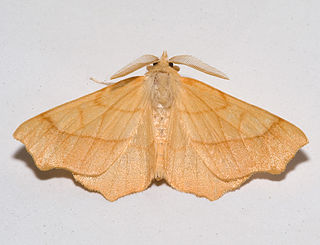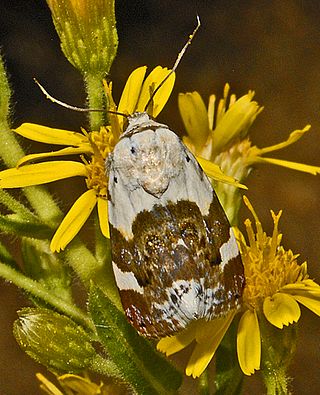
The oak hook-tip is a moth of the family Drepanidae. It is part of the Drepana subgenus Watsonalla. It is found in most of Europe except the far north. It is quite common in England and Wales, but not found in Scotland and only recently in Ireland. The species was first described by Johann Siegfried Hufnagel in 1767.

The small fan-footed wave is a moth of the family Geometridae. The species was first described by Johann Siegfried Hufnagel in 1767.

The purple thorn is a moth of the family Geometridae. The species was first described by Johann Siegfried Hufnagel in 1767. It is a species of both Northern Europe and Central Europe. It has a scattered distribution in Britain but is absent from Ireland.

The marbled beauty is a moth of the family Noctuidae. The species was first described by Johann Siegfried Hufnagel in 1766. It is an abundant species throughout most of Europe east to the Urals, and it is probably the most common lichenivorous moth of the Palearctic realm.
Johann Siegfried Hufnagel was a German parson and entomologist (lepidopterist).

Chloroclysta siterata, the red-green carpet, is a moth in the family Geometridae. The species was first described by Johann Siegfried Hufnagel in 1767.

Eupithecia innotata, the angle-barred pug, is a moth of the family Geometridae. The species was first described by Johann Siegfried Hufnagel in 1767. It ranges from Spain in the west to western Siberia and Central Asia in the east.

Cyclophora albipunctata, the birch mocha, is a moth of the family Geometridae. The species was first described by Johann Siegfried Hufnagel in 1767. It is found in the Palearctic. The southern boundary runs westward along the French Atlantic coast and to the British Isles and north of the Alps. In the east, the species ranges to the Pacific Ocean. South of the northern Alps line, it is found at some high elevation areas and mountains. In the Pyrenees, the Massif Central, the southern Alps, the northern Dinaric Alps, in the western and northern Carpathians, in northern Turkey and the Caucasus. In the north, the range extends up to the Arctic Circle. In the Far East the nominate subspecies is replaced by Cyclophora albipunctata griseolataStaudinger, 1897.

Ennomos quercinaria, the August thorn, is a moth of the family Geometridae. The species can be found in Europe. It was first described by Johann Siegfried Hufnagel in 1767.

Phibalapteryx virgata, the oblique striped, is a moth of the family Geometridae. The species was first described by Johann Siegfried Hufnagel in 1767 and it is found throughout Europe.

Caradrina morpheus, the mottled rustic, is a moth of the superfamily Noctuoidea. The species was first described by Johann Siegfried Hufnagel in 1766. It is found across the Palearctic from northern Europe to Siberia, Amur and Korea. Also in Armenia and Turkestan. It was accidentally introduced on both the east and west coasts of Canada and is so far reported in the east from New Brunswick to Ontario, and in the west from British Columbia.

Idaea serpentata, the ochraceous wave, is a moth of the family Geometridae. The species was first described by Johann Siegfried Hufnagel in 1767. It is found in most of continental Europe and the Near East.

Fagivorina is a genus of moth in the family Geometridae.

Scopula rubiginata, the tawny wave, is a moth of the family Geometridae. The species was first described by Johann Siegfried Hufnagel in 1767.

Acontia lucida, the pale shoulder, is a moth of the family Noctuidae. The species was first described by Johann Siegfried Hufnagel in 1766.

Hydrelia flammeolaria, the small yellow wave, is a moth of the family Geometridae. The species was first described by Johann Siegfried Hufnagel in 1767 It is found in most of the Palearctic realm, from western Europe to Japan.

Parectropis similaria, the brindled white-spot, is a moth of the family Geometridae. The species was first described by Johann Siegfried Hufnagel in 1767. It is found in most of Europe.
This page is based on this
Wikipedia article Text is available under the
CC BY-SA 4.0 license; additional terms may apply.
Images, videos and audio are available under their respective licenses.
















